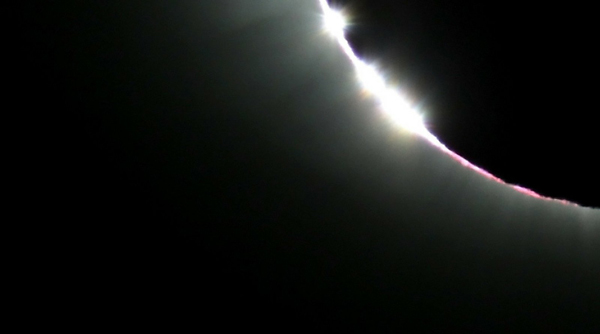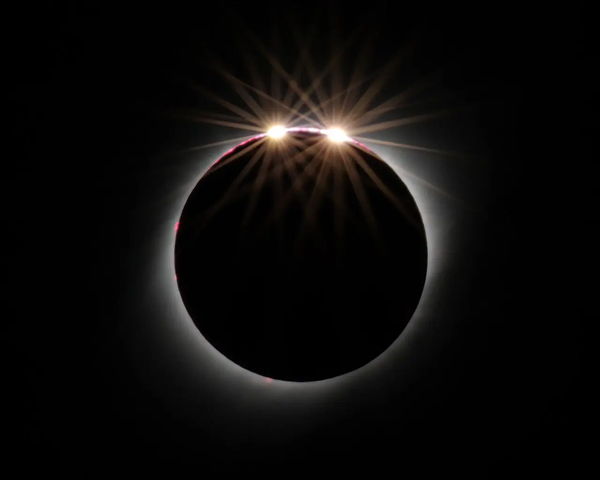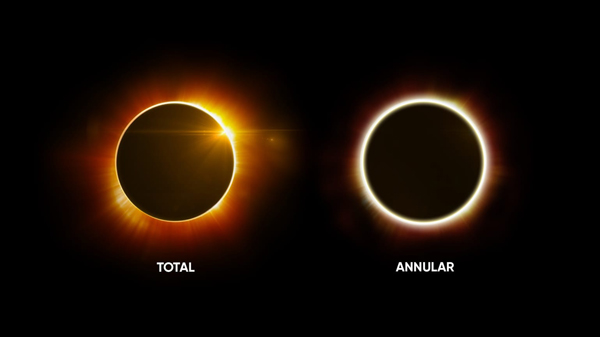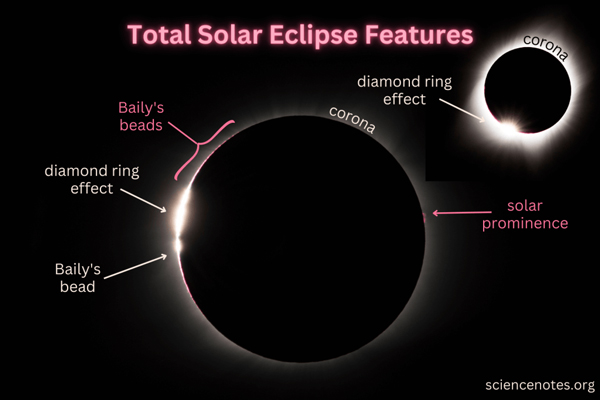Baily’s Beads
Beaded solar eclipses occur during an eclipse when the Sun and Moon have nearly identical apparent sizes. During a beaded eclipse, the rim of the Moon displays Baily’s Beads at many points all around the Moon.
The Moon exhibits fantastic topography (relief) with towering mountain peaks, thousands of craters, and deep valleys which have never been subject to weathering.

The Baily’s Beads effect occurs during a total solar eclipse when gaps in the Moon’s rugged terrain at the lunar limb (edge of the moon) allow sunlight to pass through just before the total phase of the eclipse. It looks like a sequence of small beads (pearls and droplets) of sunlight poking out from around the Moon’s black shadow.
The irregularities of the lunar limb profile are known accurately from observations of grazing occultations (passing in front of celestial objects). Astronomers thus have a fairly good idea which mountains and valleys will cause the beads to appear in advance of the eclipse.

The Diamond Ring effect occurs when these beads quickly disappear one by one until only one is left and occurs during a total solar eclipse. Just before totality and again, right before it ends, the Moon almost fully covers the Sun, leaving a final bright spot of sunlight that resembles a diamond ring. Observers (who require UV eye protection) see first a gradual covering of the Sun by the lunar silhouette for around one to four minutes, then the Baily’s beads disappear behind the advancing lunar edge (to reappear at the end of totality), followed by the diamond ring effect (visible without filters) as the last remnant of the photosphere disappears.
A Double Diamond Ring is rare, and occurs when 2 broad lunar valleys lie suitably close to each other, according to the magnitude of the eclipse. The image opposite was photographed during the 2 July 2019 total solar eclipse from the Cerro Tololo Inter-American Observatory north of Santiago, Chile.
Find out more about this image here.
There is a difference between a total eclipse and an annular eclipse. A Total Eclipse occurs when the Moon completely covers the Sun, casting a shadow (umbra) on Earth.
Observers within the umbra experience complete darkness during the day. Annular eclipses are a very special type of solar eclipse. During an annular eclipse, the Moon is centred in front of the Sun but doesn’t completely obscure it, instead leaving a ring of sunlight visible around the Moon’s edges.

This circle of light is called an annulus, or “ring of fire.” Annular solar eclipses happen only when the Moon is at the furthest point from Earth in its orbit, making the Moon appear smaller than usual from the Earth.
Some argue that Baily’s Beads are actually better observed during annular eclipses rather than total, because the larger Moon at total eclipses makes far fewer and shorter-lived beads than at the path edge at annularity, when the smaller Moon means the cusps of the solar crescent are long and thin, giving better Bailey’s Beads than the fat, stubby cusps around totality.
Who was Francis Baily?
Although Baily is often said to have discovered the cause of this feature, Sir Edmond Halley made the first recorded observations of Baily’s beads in 1715 and correctly ascertained the cause of the effect. Francis Baily was a 19th-century English astronomer and one of the founding members of the Royal Astronomical Society (RAS). Following success in the financial world as an actuary he then devoted himself to astronomy. Baily was heavily invested in the preparation of star catalogues and was awarded the RAS’s Gold Medal for his accomplishments. He was also elected an unprecedented four times as the organization’s president. During his tenure, he became interested in solar eclipses.
When the annular eclipse of May 15, 1836 occurred and the path of annularity passed through southern Scotland, Baily packed a 2.6-inch f/15 refractor telescope, four pocket chronometers, and travelled north to Inch Bonney. It is not safe to view Baily’s beads or the diamond ring effect without proper eye protection because in both cases the photosphere is still visible. but we do not know precisely what type of protection Baily used. The term “Baily’s beads” then came into use after he described those shining “diamonds set in a bright ring around the lunar silhouette” to the RAS in 1836.
Having observed the solar eclipse of 15 May 1836 from Jedburgh, he reported that: “…when the cusps of the sun were about 40 degrees asunder, a row of lucid points, like a string of beads, irregular in size, and distance from each other, suddenly formed around that part of the circumference of the moon that was about to enter on the sun’s disc…” thus triggering worldwide interest in the phenomenon.

With thanks to Hugh Hudson’s Sunsketcher talk to SIGMA in Sept 2024, which inspired me to find out more!
Jackie Eadie
